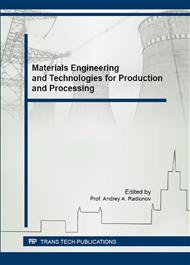[1]
V.V. Shelyagin, Magnesia Cement (Raw Materials, Technology of Production and Properties), Stroyizdat, Leningrad, (1933).
Google Scholar
[2]
A.Y. Vaivade, Magnesia Binders, Riga, (1972).
Google Scholar
[3]
T. Tanaka, E. Mosheku, I. Kekaisi, Ceram. assoc. Japan. 62 (1954) 699.
Google Scholar
[4]
V.I. Vereshchagin, V.N. Smirenskaya, S.V. Erdman, Waterproof Mixed Magnesia Binders, Glass and Ceramics. 1 (1997) 41-46.
Google Scholar
[5]
S.G. Golovnev, A.V. Kiyanets, V.M. Gorbanenko, Advantages of Magnesia Screeds, Housing Construction. 7 (2004) 27-28.
Google Scholar
[6]
S.G. Golovnev, A.V. Kiyanets, K.V. Dyakov, Highly Efficient Construction Technologies and Materials Based on Magnesia Binder, Academic Gazette Institute UralNIIproekt RAASN,. 3 (2009) 86-87.
Google Scholar
[7]
S.G. Golovnev, A.V. Kiyanets, K.V. Dyakov, Magnesium Concrete and Solutions in Modern Construction, Academic Gazette Institute UralNIIproekt RAASN,. 1 (2009) 72-73.
Google Scholar
[8]
S.G. Golovnev, Modern Construction Technologies: monograph, South Ural State University Publishing Center, Chelyabinsk, (2010).
Google Scholar
[9]
S.G. Golovnev, The Technology of Concrete Work in the Winter: the text of lectures, South Ural State University Publishing House, Chelyabinsk, (2004).
Google Scholar
[10]
B.M. Krasnovskii, Engineering Physics Fundamentals of Winter Concreting, Publishing House GASIS, Moscow, (2007).
Google Scholar
[11]
I.N. Akhverdov, Basic Physics of Concrete, Stroyizdat, Moscow, (1981).
Google Scholar
[12]
Y.M. Bazhenov, The Technology of Concrete, Publishing House of the DIA, Moscow, (2002).
Google Scholar
[13]
V.G. Batrakov, Modified Concrete, Stroyizdat, Moscow, (1998).
Google Scholar
[14]
I.B. Zasedatelev, V.G. Petrov-Denisov, Heat and Mass Transfer in Special Industrial Concrete Structures, Stroyizdat, Moscow, (1973).
Google Scholar
[15]
I.A. Kireenko, Concrete, Stone and Plaster Work in Cold Weather, Gosstroiizdat the USSR, Kiev, (1962).
Google Scholar
[16]
S.A. Mironov, Theory and Methods of Winter Concreting, third ed., Stroyizdat, Moscow, (1975).
Google Scholar
[17]
S.G. Golovnev, Winter Concreting Technology. Parameters Optimization and Selection Methods, South Ural State University Publishing House, Chelyabinsk, (1999).
Google Scholar
[18]
H. Miettinen, Y. Vuorinen, H. Kukko, Comparison of Codes Concerning Winter Concreting in Finland and in the Soviet Union, Espoo, Huhtekuu, (1981).
Google Scholar
[19]
H.B. Wenzb, Use Your Concrete Thermometer, Concrete Construction. 22 (1977) 267-269.
Google Scholar
[20]
GOST 1216-87, Magnesite Caustic Powder. Technical Conditions.
Google Scholar
[21]
GOST 10180-90, Concrete. Methods for Determining the Strength of the Reference Samples.
Google Scholar
[22]
GOST 17624-87, Concrete. Ultrasonic Method for Strength Determining.
Google Scholar
[23]
GOST 22690-88, Concrete. Determination of Mechanical Methods of Non-Destructive Testing.
Google Scholar
[24]
GOST 18105-2010, Concrete. Rules for Monitoring and Safety Evaluation.
Google Scholar


